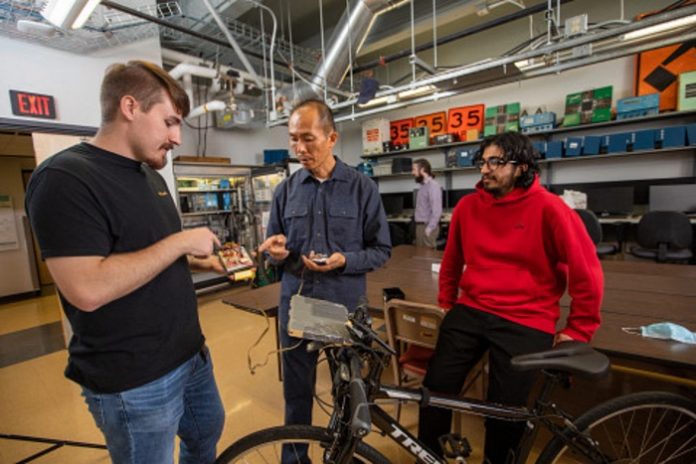According to a report by Allied Market Research, the global market for ‘smart’ cars—vehicles featuring a range of technologies and connectivity solutions featuring geospatial and remote sensing—has grown dramatically in recent years, and is expected to reach $225.16 billion by 2027.
Manufacturers haven’t yet incorporated these advanced technologies into bicycles, however, on a level widespread enough to make smart bikes affordable. But the industry recognizes that as the challenge of reducing global greenhouse gas emissions grows, the need to encourage more people to use bicycles instead of cars is becoming more urgent—and a critical component of this imperative is making cycling safer and easier for cyclists to share road conditions and other factors with other cyclists and with municipal managers.
A team of engineers at Northern Arizona University is working to address this need. Associate professor Chun-Hsing Ho and associate professor Brendan Russo of NAU’s Department of Civil and Environmental Engineering and assistant professor Steven Gehrke of NAU’s Department of Geography, Planning, and Recreation are developing an instrumented bike that improves bike efficiency, safety and mobility—all of which will help promote cycling activities, thereby reducing emissions.
The bike will be equipped with a sensor logger and a video device that will be linked to a mobile app and a cloud server/website to detect real-time quality of cycling infrastructure systems such as bike trails, sidewalks and pedestrian pathways. This information can be immediately shared with cyclists and municipal authorities who manage the cycling infrastructure so that cyclists will be aware of upcoming potential hazards and be able to adjust their cycling route accordingly, and road managers will be able to effectively prioritize their maintenance needs.
Funded through a grant from the U.S. Department of Transportation University Transportation Center Pacific South Region managed by University of Southern California, the research team will hire a graduate student and one or two undergraduate students to facilitate the sensor assembling and bicycling both in the laboratory and the field.
“This technology presents an untapped potential to assess bike facility surface conditions,” Ho said. “With the continued growth in cycling activity and infrastructure throughout the country, the question of how to obtain real time information on cycling facilities that would help better maintain the quality of these facilities and provide safe environment for cyclists has become a concern among city, county and state engineers.”
The instrumented bike will be designed to travel along bike trails and other locations where cyclists ride but motor vehicles cannot access to collect vibration responses and record videos. All vibration and video data collected from cycling will be wirelessly transferred to the cloud server for computing using the algorithms developed in the project. Any identified potential hazards (for example, severe potholes, bumps, cracks, etc.) will be georeferenced and displayed in both computers and smart mobile phones. By equipping bikes with sensors, existing trail geometric and surface conditions can be examined and quantified, and potential hazards on a bike route can be analyzed, identified and communicated to other riders.
As a civil engineer, Ho’s research interests bring together emerging technologies using engineering principles, innovative construction materials, data analytics, computing algorithms, sensing and geographic information system (GIS) mapping to provide a variety of analysis methods that enable his research team to better assess the performance of civil infrastructure systems and built environments under the effect of extreme events. His goal is to promote the sustainability and longevity of the pavement systems to increase the life cycle of structures.















